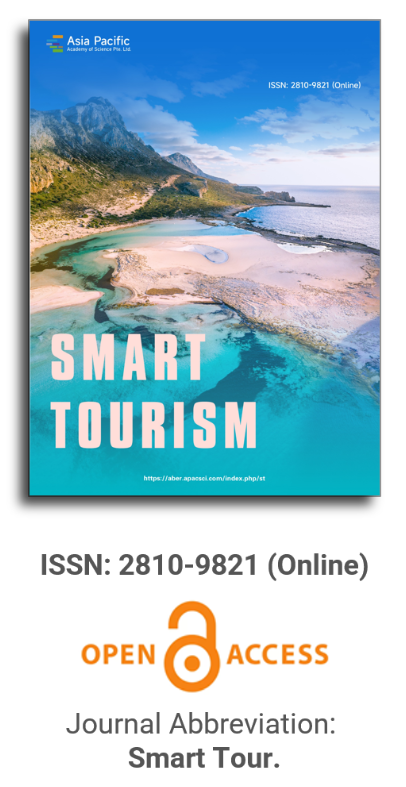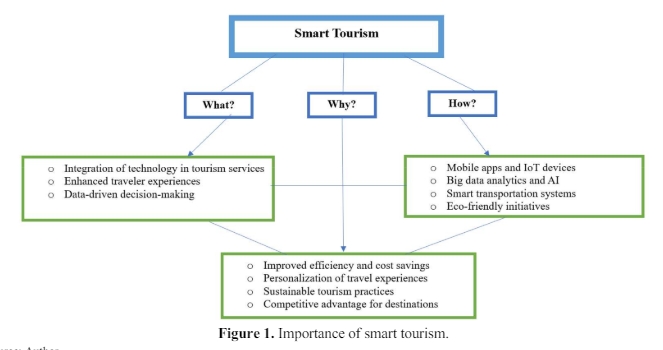


Technology, destination marketing and tourism: What, why and way forward
Vol 4, Issue 2, 2023
Download PDF
Abstract
This study thoroughly examines the dynamic relationship between technology and destination marketing in the tourist sector. It offers a detailed analysis of articles sourced from the Scopus database. The research seeks to both strengthen the current understanding of the topic and shed light on potential opportunities for future investigation and advancement in tourist practices. Following the COVID-19 epidemic, there has been a significant increase in interest and investment in technology and destination marketing within the tourism industry. The analysis of 32 meticulously chosen articles unveils a fascinating storyline of how technology has emerged as a major aspect of improving services and communication across all domains of the tourism sector. Every article received rigorous examination, taking into account important factors such as the study’s goals, methods of data collection, processes of synthesis, and indications of quality. The findings of this systematic review highlight the increasing importance of technological breakthroughs in transforming the tourist industry, especially in addressing the difficulties brought about by the global health crisis. The numbers obtained from this study not only provide insight into the present situation but also serve as a significant asset for predicting the future technology impact on the tourism industry. Outside of academic circles, these findings have practical consequences for politicians and professionals in the sector. The study indicates the necessity of creating proactive rules that promote the development of technological capabilities and guarantee the long-term viability of the tourism sector. This research adds to the continuing discussion on the influential impact of technology in destination marketing. It offers valuable insights that enable stakeholders to adapt and innovate in the changing context. This study serves as a call to action for all stakeholders involved in the tourist sector to embrace and utilize technology for its improvement as we move forward into a future influenced by technological breakthroughs.
Keywords
References
- Dwyer L, Edwards D, Mistilis N, et al. Destination and enterprise management for a tourism future. Tourism Management 2009; 30(1): 63–74. doi: 10.1016/j.tourman.2008.04.002
- Neuburger L, Beck J, Egger R. The ‘Phygital’ tourist experience: The use of augmented and virtual reality in destination marketing. In: Tourism Planning and Destination Marketing. Emerald Publishing Limited; 2018. pp. 183–202. doi: 10.1108/978-1-78756-291-220181009
- Dickinson JE, Ghali K, Cherrett T, et al. Tourism and the smartphone app: Capabilities, emerging practice and scope in the travel domain. Current Issues in Tourism 2012; 17(1): 84–101. doi: 10.1080/13683500.2012.718323
- Buhalis D. Marketing the competitive destination of the future. Tourism Management 2000; 21(1): 97–116. doi: 10.1016/s0261-5177(99)00095-3
- Benur AM, Bramwell B. Tourism product development and product diversification in destinations. Tourism Management 2015; 50: 213–224. doi: 10.1016/j.tourman.2015.02.005
- Marasco A, Buonincontri P, van Niekerk M, et al. Exploring the role of next-generation virtual technologies in destination marketing. Journal of Destination Marketing & Management 2018; 9: 138–148. doi: 10.1016/j.jdmm.2017.12.002
- Dorcic J, Komsic J, Markovic S. Mobile technologies and applications towards smart tourism—State of the art. Tourism Review 2019; 74(1): 82–103. doi: 10.1108/tr-07-2017-0121
- Xiang Z, Wang D, O’Leary JT, et al. Adapting to the Internet. Journal of Travel Research 2014; 54(4): 511–527. doi: 10.1177/0047287514522883
- Magasic M, Gretzel U. Travel connectivity. Tourist Studies 2020; 20(1): 3–26. doi: 10.1177/1468797619899343
- Susskind AM, Bonn MA, Dev CS. To look or book: An examination of consumers’ apprehensiveness toward Internet use. Journal of Travel Research 2003; 41(3): 256–264. doi: 10.1177/0047287502239033
- Kim WG, Lee C, Hiemstra SJ. Effects of an online virtual community on customer loyalty and travel product purchases. Tourism Management 2004; 25(3): 343–355. doi: 10.1016/s0261-5177(03)00142-0
- Reisinger Y, Mavondo F. Cultural differences in travel risk perception. Journal of Travel & Tourism Marketing 2006; 20(1): 13–31. doi: 10.1300/J073v20n01_02
- Figueroa D, Figueroa F, Calvo R, et al. Platelet-rich plasma use in anterior cruciate ligament surgery: Systematic review of the literature. Arthroscopy: The Journal of Arthroscopic & Related Surgery 2015; 31(5): 981–988. doi: 10.1016/j.arthro.2014.11.022
- Moher D. Preferred reporting items for systematic reviews and meta-analyses: The PRISMA statement. Annals of Internal Medicine 2009; 151(4): 264. doi: 10.7326/0003-4819-151-4-200908180-00135
- Tranfield D, Denyer D, Smart P. Towards a methodology for developing evidence—Informed management knowledge by means of systematic review. British Journal of Management 2003; 14(3): 207–222. doi: 10.1111/1467-8551.00375
- Seth S, Lewis AJ, Galbally M. Perinatal maternal depression and cortisol function in pregnancy and the postpartum period: a systematic literature review. BMC Pregnancy and Childbirth 2016; 16(1). doi: 10.1186/s12884-016-0915-y
- Durach CF, Kembro JH, Wieland A. How to advance theory through literature reviews in logistics and supply chain management. International Journal of Physical Distribution & Logistics Management 2021; 51(10): 1090–1107. doi: 10.1108/ijpdlm-11-2020-0381
- Prats L, Guia J, Molina FX. How tourism destinations evolve: The notion of tourism local innovation system. Tourism and Hospitality Research 2008; 8(3): 178–191. doi: 10.1057/thr.2008.24
- Pencarelli T. The digital revolution in the travel and tourism industry. Information Technology & Tourism 2019; 22(3): 455–476. doi: 10.1007/s40558-019-00160-3
- Fernandes DL, Bernier ET. Virtual accessibility in intelligent tourism destinations: The cases of Curitiba and Malaga. Smart Tourism 2021; 2(1): 12. doi: 10.54517/st.v2i1.1717
- Kuflik T, Wecker AJ, Lanir J, et al. An integrative framework for extending the boundaries of the museum visit experience: Linking the pre, during and post visit phases. Information Technology & Tourism 2014; 15(1): 17–47. doi: 10.1007/s40558-014-0018-4
- González-Rodríguez MR, Martínez-Torres R, Toral S. Post-visit and pre-visit tourist destination image through eWOM sentiment analysis and perceived helpfulness. International Journal of Contemporary Hospitality Management 2016; 28(11): 2609–2627. doi: 10.1108/ijchm-02-2015-0057
- Hays S, Page SJ, Buhalis D. Social media as a destination marketing tool: its use by national tourism organisations. Current Issues in Tourism 2013; 16(3): 211–239. doi: 10.1080/13683500.2012.662215
- Han DI, tom Dieck MC, Jung T. User experience model for augmented reality applications in urban heritage tourism. Journal of Heritage Tourism 2017; 13(1): 46–61. doi: 10.1080/1743873x.2016.1251931
- Magnelli A, Pantile D, Falcone R, et al. The video guides at the Musei Civici in Rome: An example of technological innovation in touristic cultural heritage experiences. In: Smart Innovation, Systems and Technologies. Springer; 2019. pp. 199–209. doi: 10.1007/978-981-15-2024-2_18
- Roy BK, Pagaldiviti SR. Advancements in arena technology: Enhancing customer experience and employee adaptation in the tourism and hospitality industry. Smart Tourism 2023; 4(1). doi: 10.54517/st.v4i1.2330
- Seraj M. We create, we connect, we respect, therefore we are: Intellectual, social, and cultural value in online communities. Journal of Interactive Marketing 2012; 26(4): 209–222. doi: 10.1016/j.intmar.2012.03.002
- Bolan P, Williams L. The role of image in service promotion: focusing on the influence of film on consumer choice within tourism. International Journal of Consumer Studies 2008; 32(4): 382–390. doi: 10.1111/j.1470-6431.2008.00672.x
- Beck J, Rainoldi M, Egger R. Virtual reality in tourism: A state-of-the-art review. Tourism Review 2019; 74(3): 586–612. doi: 10.1108/tr-03-2017-0049
- Meng Y, Jian Z, Zhang G. A case study on tourism spatial pattern and its influencing factors from the perspective of real and virtual tourism economic at county scale in Yellow River Economic Belt. Smart Tourism 2020; 1(1). doi: 10.54517/st.v1i1.1691
- Mandal S. Brief introduction of virtual reality & its challenges. International Journal of Scientific & Engineering Research 2013; 4(4): 304–309.
- Carrozzino M, Bergamasco M. Beyond virtual museums: Experiencing immersive virtual reality in real museums. Journal of Cultural Heritage 2010; 11(4): 452–458. doi: 10.1016/j.culher.2010.04.001
- Tussyadiah IP, Jung TH, tom Dieck MC. Embodiment of wearable augmented reality technology in tourism experiences. Journal of Travel Research 2017; 57(5): 597–611. doi: 10.1177/0047287517709090
- Kim YH, Kim M, Goh BK. An examination of food tourist’s behavior: Using the modified theory of reasoned action. Tourism Management 2011; 32(5): 1159–1165. doi: 10.1016/j.tourman.2010.10.006
- Hasni MJS, Farah MF, Adeel I. The technology acceptance model revisited: Empirical evidence from the tourism industry in Pakistan. Journal of Tourism Futures 2021. doi: 10.1108/jtf-09-2021-0220
- Soliman M. Extending the theory of planned behavior to predict tourism destination revisit intention. International Journal of Hospitality & Tourism Administration 2019; 22(5): 524–549. doi: 10.1080/15256480.2019.1692755
- Cohen SA, Prayag G, Moital M. Consumer behaviour in tourism: Concepts, influences and opportunities. Current Issues in Tourism 2013; 17(10): 872–909. doi: 10.1080/13683500.2013.850064
- Reza Jalilvand M, Samiei N. The impact of electronic word of mouth on a tourism destination choice. Internet Research 2012; 22(5): 591–612. doi: 10.1108/10662241211271563
- Borgerson JL, Schroeder JE. Ethical issues of global marketing: avoiding bad faith in visual representation. European Journal of Marketing 2002; 36(5/6): 570–594. doi: 10.1108/03090560210422399
- Ishida K, Slevitch L, Siamionava K. The effects of traditional and electronic word-of-mouth on destination image: A case of vacation tourists visiting Branson, Missouri. Administrative Sciences 2016; 6(4): 12. doi: 10.3390/admsci6040012
- Shu M, Scott N. Influence of social media on Chinese students’ choice of an overseas study destination: An information adoption model perspective. Journal of Travel & Tourism Marketing 2014; 31(2): 286–302. doi: 10.1080/10548408.2014.873318
- Tan Y, Jia J, Peng S, et al. Survey on some key technologies of virtual tourism system based on Web3D. Smart Tourism 2021; 2(2). doi: 10.54517/st.v2i2.1695
- Chang RCY, Kivela J, Mak AHN. Attributes that influence the evaluation of travel dining experience: When East meets West. Tourism Management 2011; 32(2): 307–316. doi: 10.1016/j.tourman.2010.02.009
- Zhang H, Gordon S, Buhalis D, et al. Experience value cocreation on destination online platforms. Journal of Travel Research 2017; 57(8): 1093–1107. doi: 10.1177/0047287517733557
- Chi HK, Huang KC, Nguyen HM. Elements of destination brand equity and destination familiarity regarding travel intention. Journal of Retailing and Consumer Services 2020; 52: 101728. doi: 10.1016/j.jretconser.2018.12.012
- Crespo ÁH, Gutiérrez HSM, Sánchez M. The value of intelligent services and intelligent destination: From the perspective of residents. Smart Tourism 2022; 3(1): 12. doi: 10.54517/st.v3i1.1726
- Li X, Wang Y. Evaluating the effectiveness of destination marketing organisations’ websites: Evidence from China. International Journal of Tourism Research 2010; 12(5): 536–549. doi: 10.1002/jtr.772
- Pan B, MacLaurin T, Crotts JC. Travel blogs and the implications for destination marketing. Journal of Travel Research 2007; 46(1): 35–45. doi: 10.1177/0047287507302378
- Gour A, Aggarwal S, Erdem M. Reading between the lines: analyzing online reviews by using a multi-method Web-analytics approach. International Journal of Contemporary Hospitality Management 2021; 33(2): 490–512. doi: 10.1108/ijchm-07-2020-0760
- Carlisle S, Ivanov S, Dijkmans C. The digital skills divide: Evidence from the European tourism industry. Journal of Tourism Futures 2021; 9(2): 240–266. doi: 10.1108/jtf-07-2020-0114
- Fan X, Jiang X, Deng N. Immersive technology: A meta-analysis of augmented/virtual reality applications and their impact on tourism experience. Tourism Management 2022; 91: 104534. doi: 10.1016/j.tourman.2022.104534
Supporting Agencies
Copyright (c) 2023 Punit Moris Ekka, Rosy Dhall
License URL: https://creativecommons.org/licenses/by/4.0

This site is licensed under a Creative Commons Attribution 4.0 International License (CC BY 4.0).

Prof. Hung-Che Wu
Nanfang College, Guangzhou
China
Indexing & Archiving
Asia Pacific Academy of Science Pte. Ltd. (APACSCI) specializes in international journal publishing. APACSCI adopts the open access publishing model and provides an important communication bridge for academic groups whose interest fields include engineering, technology, medicine, computer, mathematics, agriculture and forestry, and environment.



.jpg)
.jpg)

.jpg)

